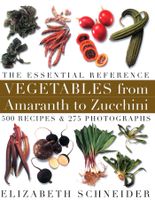Advertisement
Radicchio
Cichorium intybus

Published 2001
Including
Five Northern Italian varieties, each named for its growing region, are preeminent. By far the most common, Chioggia (or rosa di Chioggia), has become synonymous with “radicchio” in the United States: Rounded, compact, Chianti-colored, its chewy-crunchy, characteristically bittersweet leaves tend more toward the bitter. Similar, but far less common, is Verona, a more elongated head of exceptionally bright color. Early Treviso resembles a small ruby-clad romaine with nacreous ribs. The slender pearl and garnet shoots of hard-to-find Late Treviso (I couldn’t find it for the photo) swirl like the tail feathers of a tropical bird; their flavor is like assertive Belgian endive. Equally uncommon is the mildest and tenderest Castelfranco, a softly crumpled rose of wine-speckled cream or yellow, the most lettuce-like of chicories.


